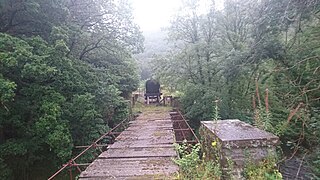
Powys is a county and preserved county in Wales. It borders Gwynedd, Denbighshire, and Wrexham to the north; the English ceremonial counties of Shropshire and Herefordshire to the east; Monmouthshire, Blaenau Gwent, Merthyr Tydfil, Caerphilly, Rhondda Cynon Taf, and Neath Port Talbot to the south; and Carmarthenshire and Ceredigion to the west. The largest settlement is Newtown, and the administrative centre is Llandrindod Wells.

The A483, officially described as the Swansea to Manchester Trunk Road, although now ending in Chester, is a major road in the United Kingdom. It runs from Swansea in Wales to Chester in England via Llandovery, Llandrindod Wells, Oswestry and Wrexham, a distance of around 153 miles (246 km).

The Cambrian Railways owned 230 miles (370 km) of track over a large area of mid Wales. The system was an amalgamation of a number of railways that were incorporated in 1864, 1865 and 1904. The Cambrian connected with two larger railways with connections to the northwest of England via the London and North Western Railway, and the Great Western Railway for connections between London and Wales. The Cambrian Railways amalgamated with the Great Western Railway on 1 January 1922 as a result of the Railways Act 1921. The name is continued today in the route known as the Cambrian Line.

Llangurig is both a village and a community in Montgomeryshire, Powys, Wales. The population was 723 in the 2011 UK Census. The community includes the hamlet of Cwmbelan.

Transport in Wales is heavily influenced by the country's geography. Wales is predominantly hilly or mountainous, and the main settlements lie on the coasts of north and south Wales, while mid Wales and west Wales are lightly populated. The main transport corridors are east–west routes, many continuing eastwards into England.

Newtown railway station is a railway station serving Newtown, Powys, Wales.

The Carmarthen–Aberystwyth line was originally a standard-gauge branch line of the Great Western Railway (GWR) in Wales, connecting Carmarthen and Aberystwyth.
The Manchester and Milford Railway was a Welsh railway company, intended to connect Manchester and the industrial areas of North West England with a deep-water port on Milford Haven, giving an alternative to the Port of Liverpool.

Strata Florida was a railway station in Wales, on the former Carmarthen to Aberystwyth Line; it served the villages of Ystrad Meurig, Pontrhydfendigaid and Ffair Rhos. The Manchester and Milford Railway (M&MR) opened from Pencader to Aberystwyth on 12 August 1867; the line went into receivership from 1875 to 1900. The site is now part of the Ystwyth Trail, a shared-use rail trail between Aberystwyth and Tregaron.
Llanfaredd Halt railway station was an unstaffed railway station opened by the Great Western Railway on 7 May 1934 on the old Mid-Wales line between Builth Wells railway station and Aberedw railway station in Powys, Wales.
The Llanidloes and Newtown Railway (L&NR) was a railway company between Llanidloes and Newtown in Montgomeryshire, Wales. It was promoted locally when plans for trunk railways passing through the locality were cancelled; local people saw that a railway connection was essential to the flannel industry in the district. The 17-mile (27 km) line opened in 1859, and at first was isolated from any other railway, but from 1861 it became connected to Oswestry by an allied railway company, and other companies also connected to it. From 1864 the company was incorporated into the new Cambrian Railways company.

The Mid-Wales Railway was conceived as a trunk route through Wales connecting industrial areas in North West England with sea ports in South West Wales. The company was prevented from reaching its goal by competing proposals in Parliament, and it was only able to build a line between Llanidloes and a junction with the Brecon and Merthyr Railway 5 miles (8 km) east of Brecon. The line was 70 miles (110 km) long and opened in 1864. The company found it impossible to raise the share subscription, but the contractor partnership of Davies and Savin agreed to build the line and take shares in payment,

Moat Lane Junction was a railway junction in Montgomeryshire near to the village of Caersws in mid-Wales. It was the junction where the Newtown and Machynlleth Railway opened in 1863 diverged from the Llanidloes and Newtown Railway which opened four years earlier. Although having only three through platforms, by rural standards it was a busy interchange station and in its heyday possessed a refreshment room.
The Oswestry and Newtown Railway was a British railway company that built a line between Oswestry in Shropshire and Newtown Montgomeryshire, now Powys. The line opened in stages in 1860 and 1861. It was conceived to open up the area to rail transport, when local opinion formed the view that the trunk railway companies would not do so. Subscription money for the construction proved very difficult to generate. It was the action of a contractor partnership, Davies and Savin, in agreeing to accept shares as the majority of their payment for construction work, that saved the company from failure.
The Oswestry, Ellesmere and Whitchurch Railway was a railway company that constructed a line from Whitchurch via Ellesmere to Oswestry. Most of the line was in Shropshire but part entered Flintshire, now Wrexham County Borough. It was seen as a link from the local railways around Newtown to the London and North Western Railway, breaking the local monopoly of the Great Western Railway. It opened as a single line in 1863 and 1864. Throughout the construction period it was short of money, and was paid for by the contractor, who took shares. Sporadically through its life it became a useful part of a through route for mineral trains, but it never developed greatly.

The Llangurig branch was a part of a proposed scheme by the Manchester and Milford Railway (M&MR) to connect industrialised Northwest England with the West Wales deep water port of Milford Haven. After various financial and construction difficulties, the 1.5 miles (2.4 km) of the Llangurig branch is noted as being the shortest lived working branch line in the United Kingdom, receiving only one train.

The Newtown and Machynlleth Railway was a railway company in Wales. It built a line from a junction with the Llanidloes and Newtown Railway near Caersws to the market town of Machynlleth; the line opened in 1862. Newtown had become the hub of railway lines in the district. Machynlleth was an important town, and extension from there to Aberystwyth and to the coast northward was in the minds of the promoters.

Llangurig railway station was intended to serve the village and rural locale of Llangurig in the Welsh county of Powys. The station, which was on the Llangurig branch, was built and operated by the Manchester and Milford Railway (M&MR). It was to be located in a shallow rock cutting just above the village.

Llandinam railway station was a station serving Llandinam, Powys, on the Llanidloes and Newtown Railway (L&NR) line. The L&NR was authorised in August 1853; construction began in October 1855 and the line was opened between those points for goods traffic only on 30 April 1859 – passengers were carried from 31 August 1859. Llandinam was one of three intermediate stations on the 13-mile line. The station was opened in 1859 by David Davies who was born in Llandinam and was a major contractor for building the line. In July 1864 the L&NR amalgamated with three other railways to create the Cambrian Railways, which in January 1922 amalgamated with the Great Western Railway which itself became part of British Railways in 1948.
















